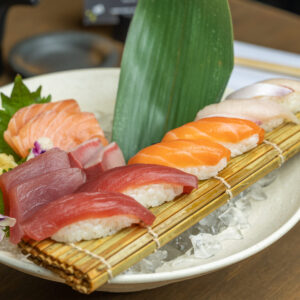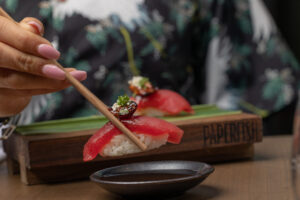Sushi is one of Japan’s most iconic culinary treasures, and among its many styles, nigiri sushi stands out as a true classic. Known for its simplicity and elegance, nigiri highlights the natural flavors of fresh seafood paired with perfectly seasoned rice. Unlike sushi rolls (maki) or sashimi (sliced raw fish), nigiri features a small, hand-pressed mound of rice topped with a slice of fish or seafood. This minimalist approach allows the quality of the ingredients and the skill of the sushi chef to shine, making it a favorite for purists and food lovers alike.
The origins of nigiri sushi
Nigiri sushi traces its roots to Japan’s Edo period, where it first appeared in Tokyo (then called Edo) in the early 1800s. Back then, sushi was a quick, convenient street food, often sold by vendors to busy city dwellers. It was a far cry from the refined dining experience we associate with sushi today – more of a fast food, meant to be eaten on the go. Over time, nigiri evolved into an art form that required years of training to master. Today, it’s a cornerstone of Japanese cuisine and a must-try dish at sushi restaurants around the world.
What makes nigiri unique?
At its core, nigiri sushi has two key components: sushi rice (shari) and a topping (neta). The rice is seasoned with a mixture of rice vinegar, sugar and salt, giving it a subtle flavor that complements the topping. Fish is the most common topping, with favorites like tuna, salmon, shrimp, eel, and yellowtail taking center stage. A small dab of wasabi is often placed between the rice and the fish to enhance the flavors. Unlike sushi rolls, nigiri is served as individual pieces, allowing you to enjoy the pure taste of each ingredient.
The craft behind nigiri
Nigiri sushi may look simple, but making it is anything but. The rice must be cooked to just the right texture – soft, yet firm enough to hold its shape. Sushi chefs spend years perfecting the art of shaping the rice by hand, ensuring that each piece has the perfect balance of firmness and fluffiness. The fish or seafood topping is sliced with precision to bring out its natural texture and flavor. In some variations, such as aburi (torched) nigiri, the topping is lightly charred to add a smoky depth. It’s this meticulous attention to detail that distinguishes exceptional nigiri.
Nigiri Sushi vs. other types of Sushi
Sushi comes in many forms, but nigiri stands out for its simplicity. Here’s how it compares to other popular styles:
- Maki (rolls): Sushi rolls wrapped in seaweed (nori) and cut into bite-sized pieces.
- Sashimi: Sliced raw fish served without rice.
- Temaki: Hand-rolled sushi in the shape of a cone.
- Chirashi: A bowl of sushi rice topped with an assortment of sashimi.
Nigiri’s minimalist approach keeps the focus on the fish and rice, without the addition of fillings or seaweed.

Variations on Nigiri Sushi
While traditional nigiri features raw fish, modern chefs have added creative twists to this classic dish. Some experiment with unique toppings, sauces, or garnishes. Aburi nigiri, for example, is lightly charred to add a smoky flavor. Other variations include marinated fish, truffle oil, citrus zest, or even foie gras. These modern twists keep nigiri exciting while staying true to its roots.
Experience premium nigiri at Paperfish Sushi
For an unforgettable nigiri experience, Paperfish offers a menu that blends traditional Japanese techniques with Peruvian influences. Some outstanding options include
- Salmon Aburi: Torched salmon with truffle oil and lime zest, balancing richness with a bright citrus kick.
- WAGYU-ni: Torched Wagyu beef with ginger wasabi, combining buttery texture with a spicy punch.
- Maguro FOIE: Tuna paired with foie gras kabayaki and pearl rice for a luxurious umami explosion.
- Hot Truffle: Scallop topped with white truffle butter and sea salt, an indulgent twist on classic nigiri.
- Hamachi Yuzu: Japanese yellowtail with Nikkei gel and negi, offering a refreshing citrus note.
Each piece is crafted by expert sushi chefs, ensuring a dining experience that celebrates the art of nigiri. Book now for expertly crafted Nikkei cuisine that combines the best of Japanese and Peruvian traditions in an ambiance designed to enhance your evening at Paperfish on Brickell or the coastal charm of Paperfish on South Beach.
How to eat nigiri like a pro
To truly appreciate nigiri sushi, follow these tips:
- Use your hands: While chopsticks are fine, nigiri is traditionally eaten with your fingers for better control.
- Dip fish side down: If using soy sauce, dip the fish (not the rice) to avoid overpowering the flavors.
- Go easy on the soy sauce: Quality nigiri is already seasoned to perfection.
- Eat in one bite: Nigiri is meant to be enjoyed in a single bite to experience the harmony of flavors.
- Cleanse the palate: Use pickled ginger (gari) between pieces to refresh your taste buds.
Where to find the best nigiri in Miami
When seeking authentic nigiri sushi, look for restaurants that emphasize fresh, high-quality fish, properly prepared sushi rice, and skilled chefs with expertise in traditional sushi-making techniques. A great sushi experience depends on the quality of the ingredients and the precision of the preparation, so it is important to choose a restaurant that values craftsmanship. If you’re looking for an exceptional nigiri experience, Paperfish offers a menu that features both classic and innovative options, all prepared with the utmost attention to detail.
Nigiri sushi is a celebration of simplicity and refinement. Its delicate balance of rice and seafood allows the natural flavors of each ingredient to shine, making it a timeless favorite. From classic preparations to modern twists, nigiri has something for everyone. The next time you’re in the mood for sushi, treat yourself to the refined elegance of nigiri and savor the artistry behind every bite.

